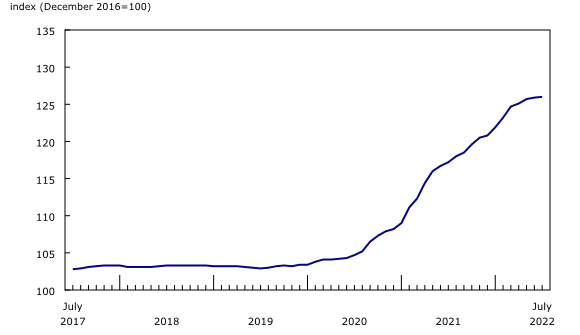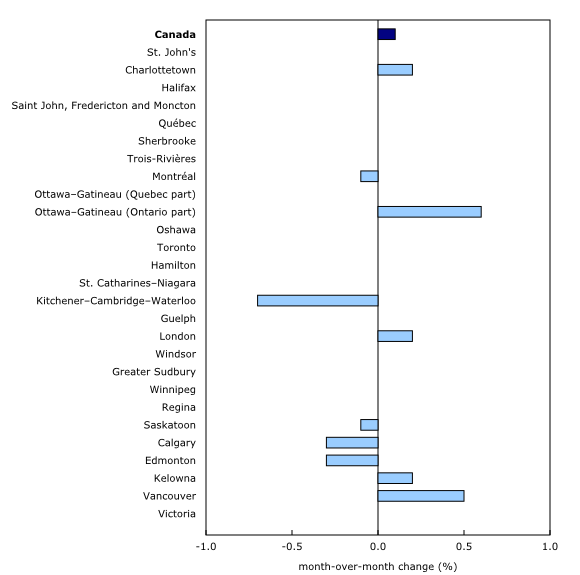New Housing Price Index, July 2022
Released: 2022-08-22
July 2022
0.1% 
(monthly change)
July 2022
0.0%
(monthly change)
July 2022
0.2% 
(monthly change)
July 2022
0.0%
(monthly change)
July 2022
0.0%
(monthly change)
July 2022
-0.1% 
(monthly change)
July 2022
0.0%
(monthly change)
July 2022
0.0%
(monthly change)
July 2022
-0.1% 
(monthly change)
July 2022
-0.3% 
(monthly change)
July 2022
0.5% 
(monthly change)
National overview
New home prices for Canada increased 0.1% in July compared with June—the smallest increase since June 2020 and below the average increases witnessed in the first two quarters of 2022 (+1.1% in the first quarter and +0.3% in the second quarter). Prices were up in 5 of the 27 census metropolitan areas (CMAs) surveyed, unchanged in 17 and down in 5.
Lower demand curbs new home prices nationally; some cities still rising
New home prices rose the most in Ottawa (+0.6%) in July, with builders reporting good market conditions as the reason for price increases for new homes. During the same period, data from the Ottawa Real Estate Board suggested that the resale market was showing signs of cooling down in Ottawa, with average home prices decreasing 7% on a monthly basis (though still increasing 5% year over year). Rising interest rates may be impacting the new home market more slowly than the resale market.
Vancouver recorded the second largest increase to new home prices in July (+0.5%), with some builders stating that increases to construction costs such as labour and materials, were playing a role. According to the Real Estate Board of Greater Vancouver, the sales-to-active-listings ratio was 11.8% for single detached homes and 20.0% for townhomes in July. A ratio below 12% indicates potential for downward price pressure, while a ratio above 20% indicates potential for upward pressure when sustained over a period of several months. The tighter market conditions for townhomes may be attributed to their relative affordability when compared with a single detached home and the larger pool of buyers who can qualify for a mortgage with this type of dwelling. The Canadian Real Estate Association's MLS® Home Price Index benchmark price for a townhome was almost half that of a single detached home in Vancouver in July.
Of the five CMAs that reported price decreases in July, Kitchener–Cambridge–Waterloo (-0.7%) recorded the largest—its first since July 2019. In July 2022, 1,174 new listings were added to the Kitchener–Waterloo market and 550 homes were sold, allowing active listings to replenish slightly. The MLS® Home Price Index benchmark price for a single-family home in Kitchener–Waterloo decreased 5.7% from June as the demand for homes declined, due in part to rising mortgage rates and inflation.
New home prices continue to moderate year over year
Nationally, new home prices rose 7.5% year over year in July—decelerating for the fourth month in a row.
Prices for new homes increased the most in Calgary for the third month in a row and were up 14.8% in July. Although lower than this time in 2021, total residential sales in July were among the highest levels recorded in the Calgary market according to the Calgary Real Estate Board. In July, the change in active listings by price range varied significantly, with listings for homes under $500,000 falling 18% and listings for homes over $500,000 increasing by 20% on a year-over-year basis. Detached (-19%) and semi-detached (-17%) homes experienced a drop in sales activity, while sales activity for apartments (+49%) and row homes (+23%) increased during the same period. A lack of lower-priced detached and semi-detached homes drove buyers towards more affordable property types such as apartments and row homes in July.
New home prices also increased in Winnipeg, up 14.5% year over year, decelerating since peaking in March 2022. Winnipeg's sales-to-listings ratio for single-family homes was 72% in the first half of 2022, down from 83% during the same period in 2021, indicating a seller's market but also the potential of buyers having more selection with less competition on pricing.
Note to readers
The New Housing Price Index (NHPI) measures changes over time in the selling prices of new residential houses. The prices are those agreed upon between the contractor and the buyer at the time the contract is signed. The detailed specifications for each new house remain the same between two consecutive periods.
The prices collected from builders and included in the index are market selling prices less value-added taxes, such as the federal Goods and Services Tax and the provincial harmonized sales tax.
The survey covers the following dwelling types: new single homes, semi-detached homes and townhomes (row or garden homes). The index is available at the national and provincial levels and for 27 census metropolitan areas (CMAs).
The index is not subject to revision and is not seasonally adjusted.
Products
The Technical Guide for the New Housing Price Index (NHPI) is available. This document provides details on the methodology used to calculate the NHPI.
The New Housing Price Index: Interactive Dashboard, which allows users to visualize statistics on new housing prices, is available.
The Housing Market Indicators dashboard, which provides access to key housing market indicators for Canada, by province and by CMA, is also available.
For more information on the topic of housing, visit the housing statistics portal.
The video Producer Price Indexes is available on the Statistics Canada Training Institute webpage. It provides an introduction to Statistics Canada's Producer Price Indexes—what they are, how they are compiled and what they are used for.
Statistics Canada launched the Producer price indexes portal as part of a suite of portals for prices and price indexes. It provides users with a single point of access to a wide variety of statistics and measures related to producer prices.
Next release
The New Housing Price Index for August will be released on September 22.
Contact information
For more information, or to enquire about the concepts, methods or data quality of this release, contact us (toll-free 1-800-263-1136; 514-283-8300; infostats@statcan.gc.ca) or Media Relations (statcan.mediahotline-ligneinfomedias.statcan@statcan.gc.ca).
- Date modified:


